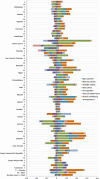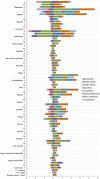Socioeconomic inequalities in HIV/AIDS prevalence in sub-Saharan African countries: evidence from the Demographic Health Surveys
- PMID: 24533509
- PMCID: PMC3930550
- DOI: 10.1186/1475-9276-13-18
Socioeconomic inequalities in HIV/AIDS prevalence in sub-Saharan African countries: evidence from the Demographic Health Surveys
Abstract
Introduction: Extant studies universally document a positive gradient between socioeconomic status (SES) and health. A notable exception is the apparent concentration of HIV/AIDS among wealthier individuals. This paper uses data from the Demographic Health Surveys and AIDS Indicator Surveys to examine socioeconomic inequalities in HIV/AIDS prevalence in 24 sub-Saharan African (SSA) countries, the region that accounts for two-thirds of the global HIV/AIDS burden.
Methods: The relative and generalized concentration indices (RC and GC) were used to quantify wealth-based socioeconomic inequalities in HIV/AIDS prevalence for the total adult population (aged 15-49), for men and women, and in urban and rural areas in each country. Further, we decomposed the RC and GC indices to identify the determinants of socioeconomic inequalities in HIV/AIDS prevalence in each country.
Results: Our findings demonstrated that HIV/AIDS was concentrated among higher SES individuals in the majority of SSA countries. Swaziland and Senegal were the only countries in the region where HIV/AIDS was concentrated among individuals living in poorer households. Stratified analyses by gender showed HIV/AIDS was generally concentrated among wealthier men and women. In some countries, including Kenya, Lesotho Uganda, and Zambia, HIV/AIDS was concentrated among the poor in urban areas but among wealthier adults in rural areas. Decomposition analyses indicated that, besides wealth itself (median = 49%, interquartile range [IQR] = 90%), urban residence (median = 54%, IQR = 81%) was the most important factor contributing to the concentration of HIV/AIDS among wealthier participants in SSA countries.
Conclusions: Further work is needed to understand the mechanisms explaining the concentration of HIV/AIDS among wealthier individuals and urban residents in SSA. Higher prevalence of HIV/AIDS could be indicative of better care and survival among wealthier individuals and urban adults, or reflect greater risk behaviour and incidence. Moreover, differential findings across countries suggest that effective intervention efforts for reducing the burden of HIV/AIDS in the SSA should be country specific.
Figures





References
-
- CSDH. Closing the Gap in a Generation: Health Equity through Action on the Social Determinants of Health. Geneva: Final Report of the Commission on Social Determinants of Health, World Health Organization; 2008. - PubMed
-
- World Health Organization. Global Report: UNAIDS Report on the Global AIDS Epidemic 2010. Geneva: WHO; 2010.
Publication types
MeSH terms
Grants and funding
LinkOut - more resources
Full Text Sources
Other Literature Sources
Medical
Research Materials
Miscellaneous

